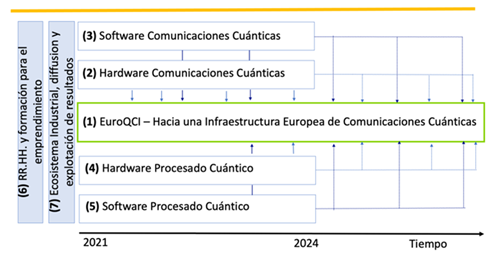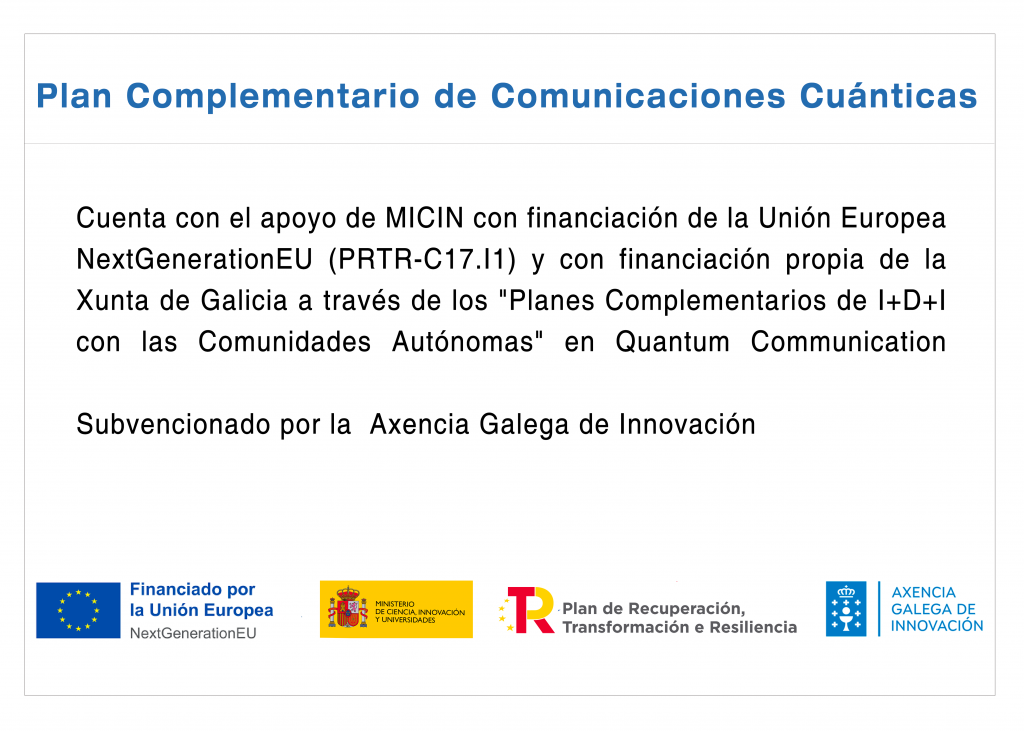Project Description
Quantum Communications (CC) is recognized as a particularly strategic sector within second generation quantum technologies, which are those that are based on the ability to manipulate quantum systems individually. This is attested by the various CC programs in many countries, from the United States to China. In Europe, CC is the only area that has two framework programs (FPA) within the Quantum Flagship and, in addition, a single 10-year infrastructure program with the aim of creating a pan-European quantum network (EuroQCI). The Quantum Communications Complementary Plan (PCCC) follows the main lines of these initiatives, contributing to their scientific-technological objectives as well as the creation of talent and the industrial ecosystem.

The general structure of the PCCC is shown in the figure above.
The program is divided into 7 lines of work. The main line (1) is given by developments and deployments that can increase its TRL in a shorter term and that meet the first objectives defined in the European programs: the creation of a highly secure communications network, resistant to any attack computational, either by classical or quantum means. This line is fed by hardware developments for CC (2) first for fiber systems –considering both technologies with greater ease of network integration and industrialization (Continuous Variables) as well as those more optimal for long distances/rates (Discrete Variables)- – and then for free space, which includes satellites, anticipating the space segment that will be necessary for the EuroQCI for very long-distance communications in the short/medium term, and communications with unmanned aerial vehicles (UAV). Likewise, within this line, technology based on entanglement will be developed, including quantum repeaters for DC over long distances (>300 km) over optical fibers. Line (3) will focus on systems and new protocols with advantages in terms of security, distance, and functionality, as well as security studies of experimental systems and their integration into networks. CCs, however, not only produce secure systems, their ultimate goal is the ability to create quantum correlations between any two points in the network. This can be used for ultra-precise distribution of time signals, quantum sensors, distributed quantum computing, etc. These quantum processing technologies, which have a lower TRL but need to be developed to get all the benefits of a future quantum internet, with key devices such as quantum repeaters, are the subject of lines (4) and (5). The hardware (HW) to enable these new applications in (4) while the software (SW) is the objective of (5). It is important to note that each line may require development in basic science. Finally, we have the necessary transversal lines that deal with the training of scientists and engineers who will advance the field, with a special emphasis on the entrepreneurial capacity (6) that, together with the creation of the industrial ecosystem and the diffusion and exploitation of the results (7), will make effective the translation of scientific knowledge into benefits for society.
In this program, CESGA participates in the following lines:
– Line 1: EuroQCI – Towards a European CC infrastructure
CESGA, together with the University of Vigo and the University of A Coruña, will carry out the deployment of an experimental line of quantum communications for the distribution of encryption keys (Quantum Key Distribution or QKD) that will link Santiago de Compostela with Vigo. Various use cases will be made on this line.
EL CESGA will also participate in the definition of the governance of these new communications links at the national level.
– Line 5: Software for quantum processing
In this line of work, the CESGA will investigate about:
1. Quantum algorithms. New quantum algorithms will be developed, fundamentally oriented towards solving problems of interest to strategic sectors.
2. Emulator Benchmarking. In this task, a methodology and a set of cases will be developed that, based on quantum application kernels, can be used to improve and evaluate the evolution of the software and hardware stack, and to compare various computing environments.
3. Distributed quantum computing. In collaboration with the University of Santiago, new algorithms and methodologies will be developed to take advantage of distributed quantum computing capabilities.
– Line 6: HR and training for innovation and entrepreneurship
Various actions will be developed to improve the training of participating researchers in innovation, patenting, business creation, etc. In addition, the appropriate ways to attract and retain talent and its projection towards innovation will be sought.
– Line 7: Innovation ecosystem and industrial, dissemination and exploitation of results
This line is oriented towards the coordination and dissemination of results.
This project is fundd by the Ministry of Science and Innovation (MICIN) through the NextGenerationEU Recovery Plan of the European Union (PRTR-C17.I1), and by the Xunta de Galicia (Galician Innovation Agency) through the ” Complementary R+D+I Plans with the Autonomous Communities” in Quantum Communication. Specifically, the participation of CESGA in the PCCC is financed through the agreements:
• COLLABORATION AGREEMENT BETWEEN THE GALICIAN INNOVATION AGENCY, THE GALICIAN PUBLIC FOUNDATION TECHNOLOGICAL SUPERCOMPUTING CENTER OF GALICIA, THE UNIVERSITY OF SANTIAGO DE COMPOSTELA, THE UNIVERSITY OF VIGO AND THE UNIVERSITY OF A CORUÑA FOR THE IMPLEMENTATION OF THE QUANTUM COMMUNICATION PROGRAM WITHIN THE SUPPLEMENTARY PLANS OF R+D+I OF THE RECOVERY, TRANSFORMATION AND RESILIENCE PLAN – FINANCED BY THE EUROPEAN UNION – NEXTGENERATIONEU.
• COLLABORATION AGREEMENT BETWEEN THE GALICIAN INNOVATION AGENCY, THE GALICIAN PUBLIC FOUNDATION TECHNOLOGICALSUPERCOMPUTING CENTER OF GALICIA, THE UNIVERSITY OF SANTIAGO DE COMPOSTELA, THE UNIVERSITY OF VIGO AND THE UNIVERSITY OF A CORUÑA TO IMPLEMENT THE CONTRIBUTION OF GALICIA TO THE DEVELOPMENT OF THE QUANTUM COMMUNICATION PROGRAM WITHIN THE SUPPLEMENTARY I D I PLANS OF THE RECOVERY, TRANSFORMATION AND RESILIENCE PLAN.


